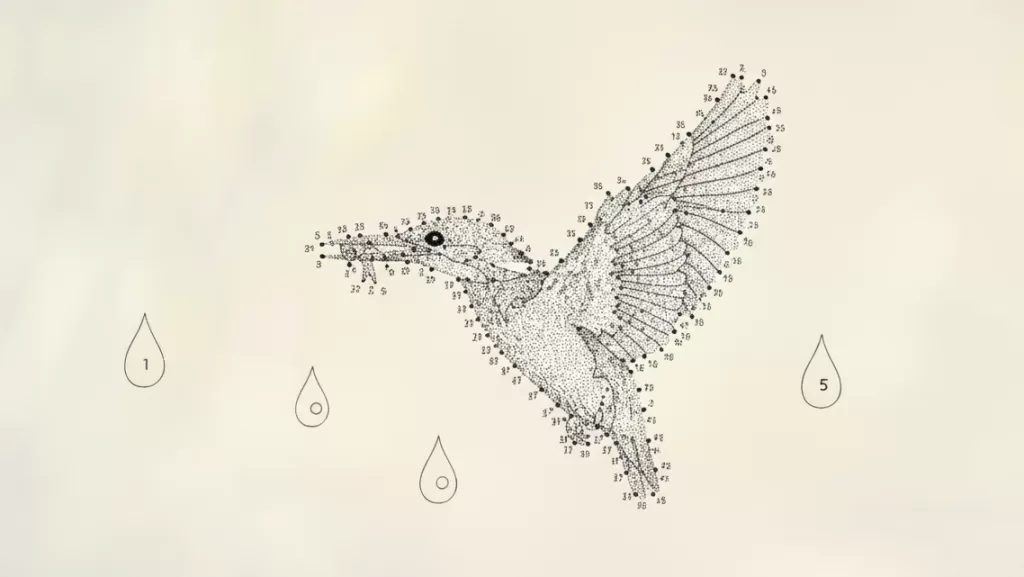
Leading a recent CPD session on retrieval practice, I found myself comparing learning to a dot-to-dot puzzle. With only a handful of dots, the picture is faint and open to guesswork. Add more, and the image begins to sharpen. The metaphor resonated among those present, perhaps because it captured a reality we can overlook: students can’t think critically about ideas they don’t yet understand.
The way we teach can be described as a three-part process: gathering the dots, revealing the picture, and challenging the picture. Each stage builds the foundation for the next.
1. Gathering the Dots: Securing Knowledge

Every learner starts with a blank page. At first, they meet isolated facts, words, and examples. Our role is to help them collect enough of these dots to form a base for meaning. Without that base, understanding stays fragile.
Retrieval practice helps us here. When students recall and revisit knowledge, they strengthen the pathways that make learning stick. Regular, low-stakes practice turns recall into recognition and information into usable knowledge. This isn’t rote learning; it’s the groundwork that allows for thought.
2. Revealing the Picture: Connecting Ideas

Once enough dots are on the page, the task is to join them. Students start to see how concepts relate, how cause leads to effect, and how details fit within a broader structure. The picture comes into focus.
This stage depends on how well teachers sequence and revisit ideas. When learning is spaced, interleaved, and applied in new contexts, links grow stronger. Understanding becomes more than simple recall when it begins to make sense. Students see not just what something is, but how and why it matters.
3. Challenging the Picture: Thinking Critically

When the outline is clear, students can step back and examine it. They can test assumptions, consider alternatives, and explore what happens if they redraw a line.
Critical and creative thinking thrive on this foundation: knowledge fuels curiosity, and curiosity deepens knowledge. The two feed each other in a virtuous loop.
Implications for the Classroom
- Plan retrieval deliberately. Integrate short, frequent opportunities for students to recall key content — quizzes, hinge questions, or brief summaries — not just as assessment tools but as learning strategies.
- Sequence for connection. Ensure curriculum content revisits and builds upon prior knowledge. Help students see relationships between topics, not just coverage of discrete units.
- Make thinking visible. Use modelling, worked examples, and think-alouds to show how dots are joined. Encourage students to explain links or visually map them.
- Teach questioning explicitly. Once understanding is secure, prompt higher-order questions: Why does this matter? What if this assumption changed? How might another perspective alter the picture?
- Encourage redrawing. Invite students to reconstruct or extend models, essays, or arguments to test their robustness. The aim is not simply reproduction but refinement.
In short, knowledge and thinking are partners, not rivals. By helping students gather, connect, and question, we turn retrieval into reasoning and memory into mastery.
From Accuracy to Agency
The more dots students have, the clearer the image and the more confident their questioning. Eventually, they can not only redraw the picture accurately but also improve it, adding nuance, detail, and new perspectives. That’s when learning moves beyond mastery to agency.
Education, in the end, isn’t about completing the picture we set before them. It’s about giving students the clarity, confidence, and courage to draw better pictures.
Further Reading
Willingham, D. T. (2009). Why Don’t Students Like School? Jossey-Bass.
Wiliam, D. (2016). Leadership for Teacher Learning. Learning Sciences International.
Mccrea, P. (2017–2024). Memorable Teaching series. John Catt.
Roediger, H. L. & Karpicke, J. D. (2006). “Test-enhanced learning: Taking memory tests improves long-term retention.” Psychological Science, 17(3), 249-255.
Roediger, H. L. & Butler, A. C. (2011). “The critical role of retrieval practice in long-term retention.” Trends in Cognitive Sciences, 15(1), 20-27.
Mccrea, P. (2020). Motivated Teaching. John Catt.
“You can know the name of a bird in all the languages of the world, but when you’re finished, you’ll know absolutely nothing whatever about the bird.”
— Richard Feynman
Subscribe to my newsletter
- Actionable insights on leadership, learning, and organisational improvement
- Thought-provoking reflections drawn from real-world experience in schools and beyond
- Curated resources on effective practice and digital strategy
- Early access to new articles, events, and consultancy updates
- Invitations to subscriber-only webinars, Q&As, and informal conversations
- Clarity, not clutter—you will not be bombarded by emails
Cancel or pause anytime.
Leave a Reply